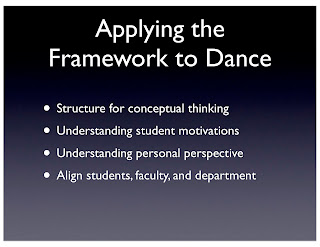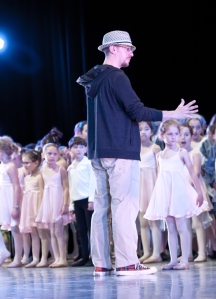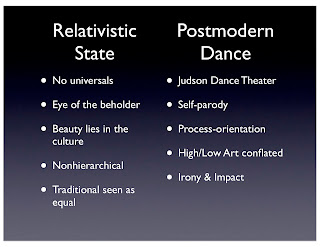Dance Paradigms (Part 9: Applications for Dance Education)
So, how can the Graves framework be incorporated and applied to dance education?
I think it can offer an organizational structure for college dance students that will introduce conceptual thinking toward their craft. While not all undergraduate students would care to understand the development of dance beyond the platitudes they often hear, some may gain a greater understanding of the ideas behind the movements.
Of all the arts, dancers are often saved from the rigors of intellectual thought  because we are physical artists and not to be labored with such thinking. However, I believe that this is an old Cartesian modernist mind-body prejudice. Presenting the information will at least give those dancers that are interested the ability to grow into knowledgeable, passionate, thinking artists. And for those who would rather not consider it, we would just accept that they are in the state that suits their current psychological conditions.
because we are physical artists and not to be labored with such thinking. However, I believe that this is an old Cartesian modernist mind-body prejudice. Presenting the information will at least give those dancers that are interested the ability to grow into knowledgeable, passionate, thinking artists. And for those who would rather not consider it, we would just accept that they are in the state that suits their current psychological conditions.
 because we are physical artists and not to be labored with such thinking. However, I believe that this is an old Cartesian modernist mind-body prejudice. Presenting the information will at least give those dancers that are interested the ability to grow into knowledgeable, passionate, thinking artists. And for those who would rather not consider it, we would just accept that they are in the state that suits their current psychological conditions.
because we are physical artists and not to be labored with such thinking. However, I believe that this is an old Cartesian modernist mind-body prejudice. Presenting the information will at least give those dancers that are interested the ability to grow into knowledgeable, passionate, thinking artists. And for those who would rather not consider it, we would just accept that they are in the state that suits their current psychological conditions. At the dance studio in Long Island I mentioned at the start of this series, I ran into an atmosphere based on traditional tribalistic values. I attempted to force a multiplistic credo that took achievement and progress as absolute imperatives.
I urged them to strive to find the techniques that would help them individually compete; they collectively were most concerned with maintaining safety and harmony within the group. I threatened that safety and the owner, as their tribal leader, took action to keep the tribe safe.
The school and I were not the right fit and we would not be unless either they matured through the Egoistic state into at least the Absolutist state (where they would appreciate the discipline) and beyond or I matured into at least the Relativistic state (where I would appreciate their recreational values).
From my perspective, many college dance programs deal with this misalignment of perspectives. Most incoming freshman enter college dance from recreational and competition studios with Egoistic values.
A smaller percentage comes from ballet conservatories with Absolutist or Multiplistic values. An even smaller percentage comes to college dance with modern dance experience and those that do tend to have modernist but not postmodernist exposure.
I propose that a successful program should understand the complexity in the diverse states of development and work to integrate this information. First, faculty should recognize what their personal preferences are, where their psychological center of gravity lies. Then, understand where the center of gravity for the class and each individual student falls.
Ultimately, when applying the Graves framework to the evolution of dance paradigms or to dance education, it is more than just understanding the best fit for the situation as I stated in the first post in this series.
A sustained career in dance in the transmodern era—whether it be a performer, teacher, or choreographer—will teach one lesson above all others: it is not about being the best, nor simply about being the best fit, but about understanding that the best fit is constantly changing and evolving.
Beck, Don Edwards & Cowan, Christopher C. Spiral Dynamics. Massachusetts: Blackwell, 2006.
Graves, Clare W. The Neverending Quest. California: ECLET, 2005.
Martin-Smith, Keith. “On the Future of Art and Art Criticism.” Integral World. N.p. N.d. Web. November 6, 2009.
Wilber, Ken. A Brief History of Everything. Boston: Shambala, 2000.
Graves, Clare W. The Neverending Quest. California: ECLET, 2005.
Martin-Smith, Keith. “On the Future of Art and Art Criticism.” Integral World. N.p. N.d. Web. November 6, 2009.
Wilber, Ken. A Brief History of Everything. Boston: Shambala, 2000.
Wilber, Ken. A Theory of Everything. Boston: Shambala, 2001.


Comments
Post a Comment